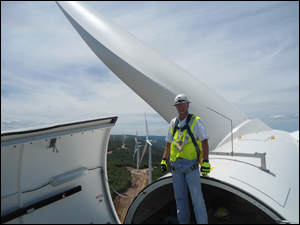DOE Wind Program Funds University of Wisconsin-Madison Wind Workforce Development Efforts: A Wind Powering America Success Story
Sept. 25, 2012

Casey Joyce, a practitioner that attended the UW-Madison Wind Energy Civil Balance-of-Plant design course, completes the mechanical checklist for a Siemens 2.3-MW turbine in eastern Pennsylvania.
The University of Wisconsin-Madison (UW-Madison) was awarded a U.S. Department of Energy (Energy Department) workforce development grant in July 2010 to develop a series of continuing education short courses focused on civil design and construction for wind energy power plants. UW-Madison was one of 16 wind workforce development projects selected for funding by the Energy Department in response to the 20% Wind Energy by 2030 funding opportunity announcement.
Major wind power expansion in the United States requires substantial numbers of skilled personnel available to design, build, operate, maintain, and advance wind power equipment and technology. The UW-Madison project reaches practicing engineers as well as university-level students and involves corollary research.
UW-Madison developed a series of continuing education courses in wind energy balance-of-plant design (i.e., civil, geotechnical, electrical, structural, and construction management for wind site development, design, and construction) with 300 attendees to date. Billions of dollars are invested each year in the United States to support the siting, design, and construction of wind energy facilities. Jim Tinjum, engineering professor and principal investigator for the project, said, "the addition of these new power facilities is becoming more difficult as economic constraints increase and the civil, structural, and geotechnical conditions for sites become ever more complex and multi-faceted." As an example of the complexity of these large wind turbine generator designs, a wind turbine foundation may include 30 tons of steel, require 400 cubic yards of concrete, and cost between $100,000 and $250,000. UW-Madison developed a unique short course on wind turbine foundation and structural tower design that has been delivered multiple times in Austin, San Jose, and Madison, with attendees from 37 states plus the District of Columbia and Puerto Rico.
UW-Madison also developed an upper-level university design class in this balance-of-plant area, which is also available online. Eighty-four students have participated in this 3-credit design course, of which at least seven are now directly working in the wind energy business. As an example, one student took the course as part of her MS degree in civil engineering and now works in Puerto Rico for the developer of the first utility-scale wind farm there. Another student now works in California on deep wind turbine foundation designs.
As a final component of the grant award, UW-Madison is collaborating with Heartland Community College in Illinois on instrumenting a foundation and evaluating the dynamic forces and the foundation soil response to in-service wind action. The project will collect data to support design of more cost-effective foundations based on geotechnical and engineering analysis as well as provide an opportunity to engage undergraduate and graduate students with the construction, analysis, and operation of a renewable energy system. Experimental results and analyses will be incorporated into the continuing education short courses.